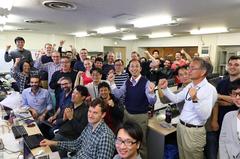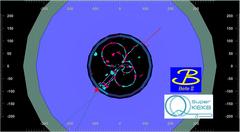URL: https://www.desy.de/news/news_search/index_eng.html
Breadcrumb Navigation
DESY News: First collisions in the upgraded SuperKEKB accelerator
News
News from the DESY research centre
First collisions in the upgraded SuperKEKB accelerator
After eight years of refurbishing, particles collided for the first time in the SuperKEKB accelerator on 26 April 2018. SuperKEKB is located at the KEK research facility in the Japanese town of Tsukuba and is meant to produce more particle collisions during its operating life than any other particle accelerator ever before. These collisions between electrons and their anti-particles, known as positrons, will take place inside the particle detector Belle II, which has also been completely redesigned, a process in which DESY and other German research groups have been integrally involved.

Cheers in the control room: the Belle II detector has recorded first collisions. Image: KEK
“We would like to convey our heartiest congratulations to our colleagues at KEK and to the Belle II team on their success. Starting up a new particle accelerator is a huge challenge. The particle physics community is very excited to see the results SuperKEKB and Belle II will produce,” says DESY’s Research Director for Particle and Astroparticle Physics, Joachim Mnich. DESY’s Carsten Niebuhr, the scientist who heads the Belle II group at DESY, adds: “It is extremely exciting to see the detectors that we have been developing and building for years coming to life bit by bit. And we hope that the scientific discoveries that we get from the generated data will be even more exciting and ground-breaking.”
The first collisions are a key milestone on the way to launching the research programme at Belle II. For about a month, particles have once again been circling inside the accelerator, which has been fitted with a new system of focusing magnets and a new damping ring. Both of these ensure that the particle beam is extremely narrow and compressed, so that as many particles as possible collide with each other, leading to a high luminosity or collision rate. An important prerequisite was achieved in January when the DESY-designed and built remote vacuum system RVC that makes a crucial connection between focus magnets and the detector was installed.

Event display from a collision in the Belle II detector. Image: KEK / Belle II collaboration
Over a period of some ten years, the accelerator is to produce some 50 billion pairs of B- and anti‑B mesons. When the Belle II detector goes into full-scale operation in early 2019, it will generate huge amounts of data, which need to be stored, reconstructed and analysed. To this end, DESY and GridKa in Karlsruhe will be contributing significant storage and computing capacities towards the experiment.



